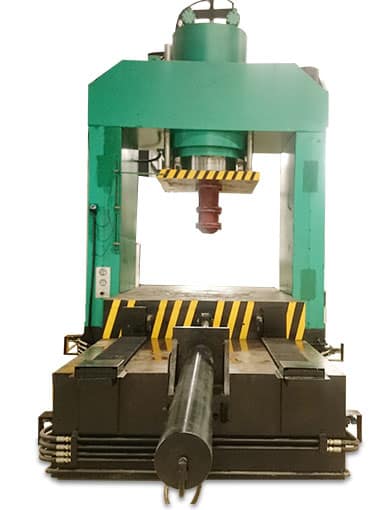Does a Hydraulic Press Make Things Heat Up?
time:2023-08-26 views:(点击 914 次)An essential tool in any workshop, the hydraulic press machine can perform tasks that would be impossible for humans alone to perform.
Hydraulic presses consist of three primary components: frame, working table (or bolster), and ram. The frame may be stationary or mobile; its hydraulic cylinder transforms hydraulic system power into kinetic energy for driving the ram.
What is a hydraulic press?
Hydraulic presses employ hydraulic systems to generate high levels of force that can crush, straighten or mold metal into desired shapes. They are also known as machine presses or Bramah presses (after their inventor Joseph Bramah). Hydraulic presses work by applying pressure to confined fluid, which produces force over an expanded area via Pascal's law2.
There are various kinds of hydraulic presses, and they can be divided into categories depending on how they transfer their power. Some feature a basic frame with a bolster while others possess more complex structures with three or more working cylinders to apply force at various levels. Size and capacity also depend on what work needs to be completed with these presses.
Hydraulic presses serve various functions, but one common use is compressing objects. Food manufacturers will often utilize hydraulic presses before packaging their food products with reduced weight and easier transportation in mind. Furthermore, using one can help increase shelf life by forcing out air and eliminating places for microorganisms to thrive.
Laboratory environments often employ hydraulic presses to prepare samples for analysis by compressing them into pellets or thin films for further examination under spectroscopic testing. This process helps eliminate air bubbles or any imperfections that might interfere with this method of study.
Hydraulic presses can also be used for various metalworking tasks, including cutting, forming, drawing, punching and coining. They are useful in compressing coils of metal sheets into blank shapes that are ready for further processing.
Hydraulic presses can also be used to stamp metal into specific shapes using hydroforming. This technique saves both time and money when compared with traditional stamping techniques; indeed, parts made out of single pieces of material can even be stamped out using this process, increasing productivity while simultaneously decreasing raw materials costs.
Why is it so hot?
Hydraulic presses are machines used to apply force at high levels. Composed of two interconnected cylinders filled with hydraulic fluid, their two ends connected by tubes called Ram and Plunger respectively, when you apply pressure to either end, it raises and pushes Ram creating tremendous force that crushes whatever comes between them.
When operating a hydraulic press, it's crucial that you follow the guidelines outlined in its user manual. Doing so will ensure the device remains safe to use without malfunctioning; additionally, check that its safety door has been closed prior to turning on your machine.
Keep your hydraulic press below 120 degrees Fahrenheit to reduce the risk of overheated oil causing damage to the machine. An air or water cooler is an effective way of maintaining an appropriate oil temperature.
Another key element to keep in mind when operating a press is using high-quality hydraulic oil that comes recommended from its manufacturer. This will ensure that it operates as efficiently as possible.
Maintenance on a hydraulic press should also be undertaken regularly, which should include cleaning the exterior, checking for leaks and tightening connections as necessary.
Hydraulic presses are frequently employed for metalworking tasks such as stamping, molding, blanking, punching, deep drawing and pressing. You'll often find them used in industrial settings as well as automotive shops or home workshops.
Have you ever watched videos showing people crushing objects in a hydraulic press? You might have noticed how hot it becomes after running for some time; this is because hydraulic presses use lots of power, transferring heat into their surroundings. To prevent this from happening, always ensure your press has been properly cooled prior to using it.
How does it get so hot?
Hydraulic presses are powerful tools used for crushing, flattening, compressing, gluing, molding and coating materials. These presses have numerous applications in multiple industries - metal forming, automotive, aerospace composites medical as well as offering full tonnage through each stroke, customization capabilities and flexibility among others.
Hydraulic presses operate by interconnecting two hydraulic fluid-filled cylinders known as the ram and plunger, respectively. The larger of the two acts to apply pressure onto a workpiece while its control by an hydraulic pump and control valve allows it to produce desired tonnage of force.
Hydraulic presses can be powerful tools, yet their misuse can be deadly. Therefore, it is crucial to understand their inner workings as well as potential issues associated with them in order to keep yourself and others safe.
Oil leaks are one of the primary problems associated with hydraulic presses, posing serious threats to machine operation and safety. They may occur due to overfilled oil reservoirs, contaminated check balls or worn piston packing that has not been regularly checked and replaced; to minimize risks related to oil leakings it's crucial that these components be regularly inspected and replaced in order to prevent leakage of pressurized oil.
Failing to build pressure is another common hydraulic press issue, and can be serious in terms of productivity loss and safety risks. Without prompt resolution, such issues may lead to decreased output as well as safety hazards for operators and workers.
Avoiding these issues requires regular inspection of the hydraulic press machine to make sure all its electrical connections are secure, and to adjust it correctly prior to starting up - please consult the user manual for more details on this matter.
Another way to prevent problems with machines is by keeping them cool. A water cooling system can help maintain lower temperatures, and prevent any overheating in your machine. Furthermore, this reduces energy use - saving money while improving efficiency.
What can you do about it?
If you are using a hydraulic press, make sure that the material being pressed is of manageable size - pressing too large of an amount could damage or injure both the machine and yourself. In addition, check that your limit switch has been properly set prior to pressing anything as this will help avoid excess pressure or machine malfunction.
The Hydraulic Press Channel is a YouTube channel featuring Finnish workshop owner Lauri Vuohensilta crushing various items with his 140-ton hydraulic press, creating unexpected results and entertaining viewers with his sense of humor. Though, some criticize its volume of heat generated.
Link to this article: https://www.ihydraulicpress.com/nsn/4350.html
Hot Articles
-
How to Make a Manual Hydraulic Press
If you need an efficient and rapid way to mark or stamp non-ferrous metal and some steels, a manual hydraulic press may be just what’s neede……
-
How Much Money Does the Hydraulic Press Channel Make?
The Hydraulic Press Channel is an addictive YouTube series where one guy crushes stuff in his shop with a hydraulic press. These videos are fun an……
-
How to Make Small Hydraulic Press at Home
When you need to apply lots of pressure to something, a hydraulic press is an invaluable tool. But buying one can be expensive; so why not build y……
-
How to Make a Ring Using a Hydraulic Press
Hydraulic presses can quickly and effectively crush, pulverize or shape a variety of materials with force and efficiency. From table top models to h……
-
How to Make a Hydraulic Press Brake
Hydraulic press brakes can bend metal with incredible accuracy and force, making parts for automotive, aerospace, and commercial equipment product……
-
How to Make a Small Hydraulic Press
If you’re searching for a hydraulic press, there are various models on the market to choose from; however, building your own for much cheape……
-
How to Make Electric Hydraulic Press Machines
Hydraulic presses use fluid pressure to compress, assemble, punch, draw, trim, stamp, shape and crush materials more precisely than traditional mech……
-
How to Make an Electric Hydraulic Press
Hydraulic presses can be an indispensable tool for metal forming, powder compacting and plastic molding – and crushing various items such as……
Latest News
-
How to Make Dies For Hydraulic Presses
Hydraulic presses are machines designed to use enormous force to shape metals and other materials. Used in industrial settings for tasks like making……
-
How to Make a Hydraulic Press at Home
Hydraulic presses are indispensable tools for any garage master, providing strength to bearings, silent blocks, or fuel briquettes. Their use requir……
-
Calculating How Much Pressure in a Hydraulic Press
Hydraulic presses are powerful machines capable of creating massive amounts of force. Their operation relies on Pascal’s law – that pr……
-
Rosin – How to Make Dabs With Hydraulic Press
Rosin is an environmentally-friendly cannabis extraction method created through pressing terpene-rich resin from flower or kief using a rosin press,……
-
How to Make a Blacksmith Hydraulic Press
Blacksmith hydraulic presses can be essential tools for metalworkers. This apparatus enables blacksmiths to accomplish more with the material than……
-
Hydraulic Press Channel – How Much Money Does the Hydraulic Press Channel Make?
Lauri Vuohensilta of Finland created The Hydraulic Press Channel and has since October 2015 been crushing things with his 150-Ton hydraulic press ……
-
How to Make a Hydraulic Press Brake
Hydraulic press brakes are essential tools in metal fabrication industries. Their versatility lies in being able to bend metal sheets into various……
-
How Much Does Hydraulic Press Channel Make?
Lauri Vuohensilta runs a family machining business in Finland and began posting videos featuring his hydraulic press crushing various objects onto……














































